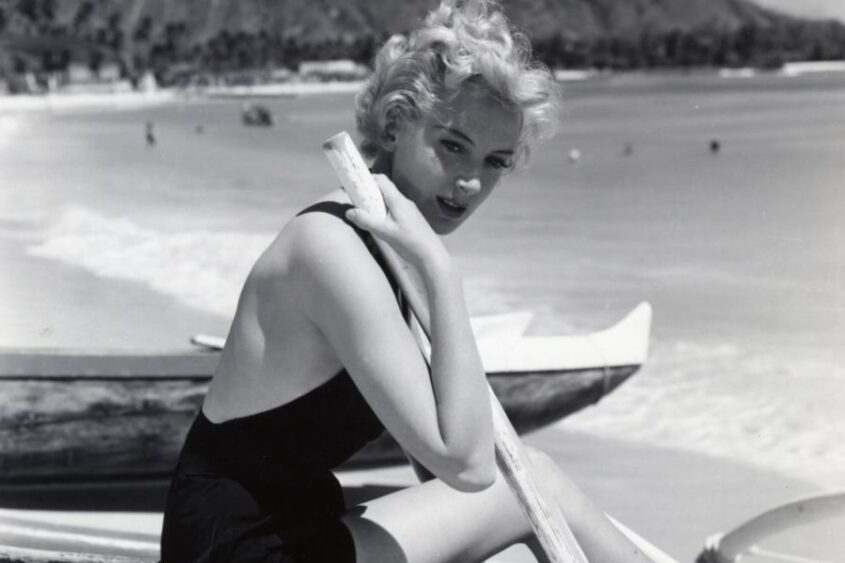(This article was updated by Joslyn Jay on Aug 5, 2025 with fresh details and additional context). In our Toast series today, we salute Oscar-winning “lady” Deborah Kerr, whose iconic portrayal of sultry Karen Holmes in From Here to Eternity, released on this August 5th day in 1953, proved that good girls can play bad, too, and brilliantly! Free of typecasting, Deborah Kerr went on to forge a truly inspirational cinematic career that is still endearing audiences today!
British actress Deborah Kerr is that lovely memory of lavender and rain. So soothing. Not before or since has a British acting import to Hollywood been held in such high, kind regard by peers, studio execs, and even tabloid media outlets. Indeed, if flipping through those dusty, bygone annals of Old Hollywood tabloids, there appears to be no negative press of this so-called “lovely lady.” No bad behavior off-screen. And on-screen? She was super-talented, known especially for her ease in portraying nannies, nuns, and you guessed it, lovely ladies.
But, who can forget Deborah Kerr’s steamy romp in the Hawaiian surf with heartthrob Burt Lancaster in 1953’s From Here to Eternity? Yes, it’s quite possibly the biggest, most luminous moment of her stellar 60+ years acting career. Cue that shimmery sand and those crashing waves, as this tryst is often referred to as the all-time “sexiest” love scene in Old Hollywood. Um, audience blushes and all.
From rolling around with Burt Lancaster on the wave-crashing beach, to her biting argument with his character just a few moments later, Deborah Kerr is modern, complex. She’s a heady combo of both fire and ice, as she positively oozes her sultry, adulterous, cigarette smoking, booze drinking, hostile hair-brushing character of Karen Holmes. (Yes, there’s a “hostile” hair-brushing scene. It’s dynamite!)
Released on this day back in 1953, From Here to Eternity is a dazzling war-time drama that boasts one of the finest acting collaborations from the era. Think Frank Sinatra, Montgomery Clift, Donna Reed, and more. It’s a powerhouse film that won a staggering eight Oscars, including Best Picture.
But importantly, it was a magical turning point for Deborah Kerr. Not only did she receive a well-deserved Oscar nom for her memorable portrayal of Karen Holmes, but she began to step out of those Old Hollywood shadows which, up until that point, had often typecast her to lesser roles that simply played into her proper British off-screen roots. No, Deborah Kerr was so much more than proper.
British Cinema Superstar
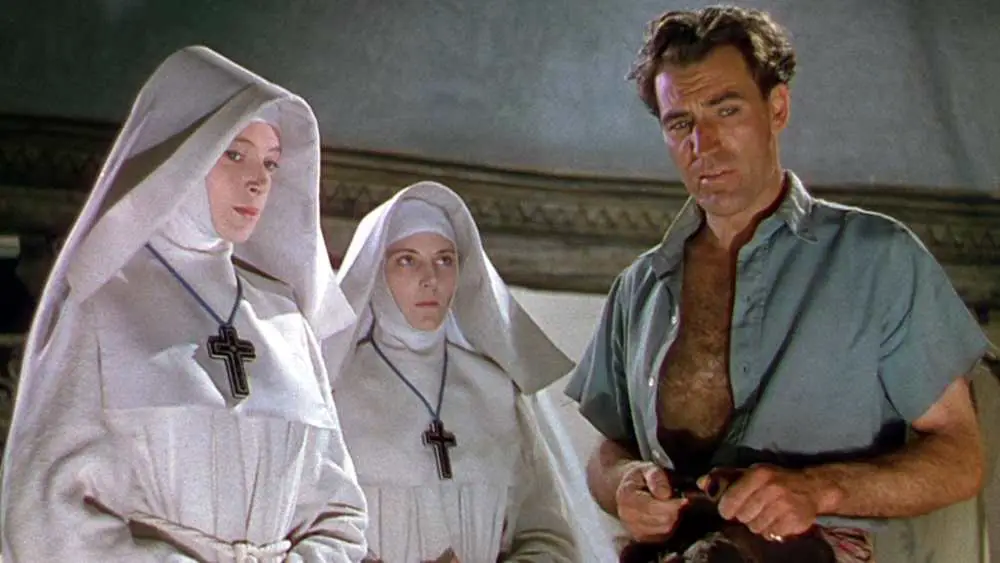
Born in Glasgow, Scotland, on September 30, 1921, and getting her acting start at the Open Air Theatre doing Shakespeare productions in London, Deborah Kerr made her film debut in 1941’s Major Barbara. After a few more films, renowned British filmmaking duo Powell and Pressburger (whom director Martin Scorsese outspokenly adores) then came calling on Deborah twice over the next decade.
Enter 1943’s The Life and Death of Colonel Blimp and 1947’s Black Narcissus. Now legend has it that British Prime Minister Churchill despised The Life and Death of Colonel Blimp so much that it wasn’t released in the USA until 1945. He objected to the film’s sympathetic portrayal of a German military man, as this film was made smack-dab in the middle of World War II. Yikes. What timing.
Yes, Deborah Kerr, who “on-screen” brilliantly plays not one, but three beautiful women, became “off-screen” an unwitting player in World War II political intrigue. Since then, this movie is often hailed as the greatest British film of all time, a true historical artifact. Watch Deborah as she effortlessly embodies Edith Hunter, Barbara Wynne, and endearingly wily, protective, tough-nut Angela Cannon (aka Johnny). As her beau from the pub describes her – “She got me… Mata Hari!”
Switching gears to 1947’s Black Narcissus, Deborah is a bona fide tour-de-force, as she plays repressed Sister Clodagh in a spooky Himalayan palace. This movie, too, is the stuff of legend. It was censored for decades, but no longer. Now who would think that a 1940s film about nuns could be erotic? Unscramble your pre-conceived notions, as this film proves just that. Aforementioned New Hollywood true-crime film director Martin Scorsese is even a huge fan. He calls Black Narcissus “a cross between Disney and a horror film.” (Sidebar – he provides excellent commentary on the Criterion Collection’s Blu-ray.)
Deborah Kerr Rhymes With Star!
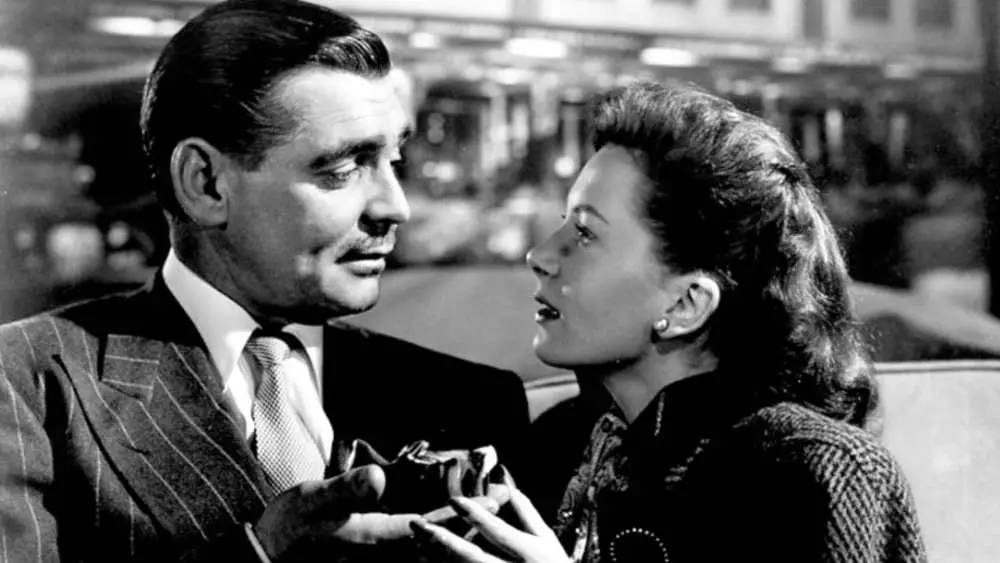
No surprise that 25-year-old Deborah would soon transition to the bright mega-watt lights of Hollywood. She made that fabled Trans-Atlantic journey, and landed in Hollywood with her first film being none other than 1947’s The Hucksters alongside “The King” Clark Gable. What an auspicious debut.
A story about a down-and-out New York City advertising executive (Clark Gable’s character) who falls for an elegant British widow (Deborah Kerr’s character) living in fancy Sutton Place, Manhattan, this film is unfortunately not all that memorable. It lacks momentum, verve, and clear messaging. But, Deborah Kerr’s performance? She was super-solid, and proved that she could hold her own right alongside the Gone With the Wind (1939) megastar. They had chemistry!
Notable, this film also debuted the slogan that would remain with Deborah Kerr throughout her long, illustrious career. Legend has it that Louis B. Mayer, owner of top Hollywood movie studio MGM, branded her, “Deborah Kerr, It Rhymes With Star!” Audiences knew that this starlet was crossing the pond from jolly ol’ England. But, did they know what to call her when she arrived? “Wait, how is that last name pronounced?”
Endearing slogan aside, Deborah followed up The Hucksters with If Winter Comes (1947) and Edward, My Son (1949). The latter was a substantial, well-rounded role for Deborah, as it allowed her to play a hopeful wife and mom who then descends into deep cynicism and sorrow, as she bears witness to the collapse of her entire family. She also turns to drinking. Deborah earned her first of six prestigious career Oscar noms.
The Typecasting Years

Though headed in the right direction, Deborah saw only moderate success during the next few years, for no fault of her own. For instance, she was tapped to star in the adventurous King Solomon’s Mines (1950), shot on-location in Africa. Considered the “definitive” version of the Solomon’s Mines cinematic story (there have been seven film adaptations over the years), this film is a highlight to Deborah’s film catalog. It’s just so authentic, rugged, romantic, and good. She and Stewart Granger fire up the screen. Displaying A-list acting prowess in the middle of the desert surrounded by fearsome wild animals? Commendable!
She also starred in Quo Vadis (1951), another on-location shoot in Italy. In Quo Vadis, Deborah plays a young woman in the throes of romance during the early days of Christianity. Though a lavish, colorful production, and definitely an “epic” film, Quo Vadis did little to showcase Deborah’s stellar acting skill.
Kerr was this supremely talented British actress who had been hungry to move to Hollywood and “show her stuff.” But, now that she was here, she was being typecast in roles that, according to Deborah, required her to only be “high-minded, long-suffering, white-gloved, and decorative.” Ouch. To all those 1940s and ‘50s studio execs, let’s give this talented woman a meaty character. A quick cameo in Julius Caesar (1953) will not suffice. Nor will a one-dimensional role in Young Bess (1953), no matter how gorgeously coiffed her sixteenth-century Queen Catherine Parr is. (Yes, Deborah truly looked exquisite.)
From Here to Eternity and Super-Stardom
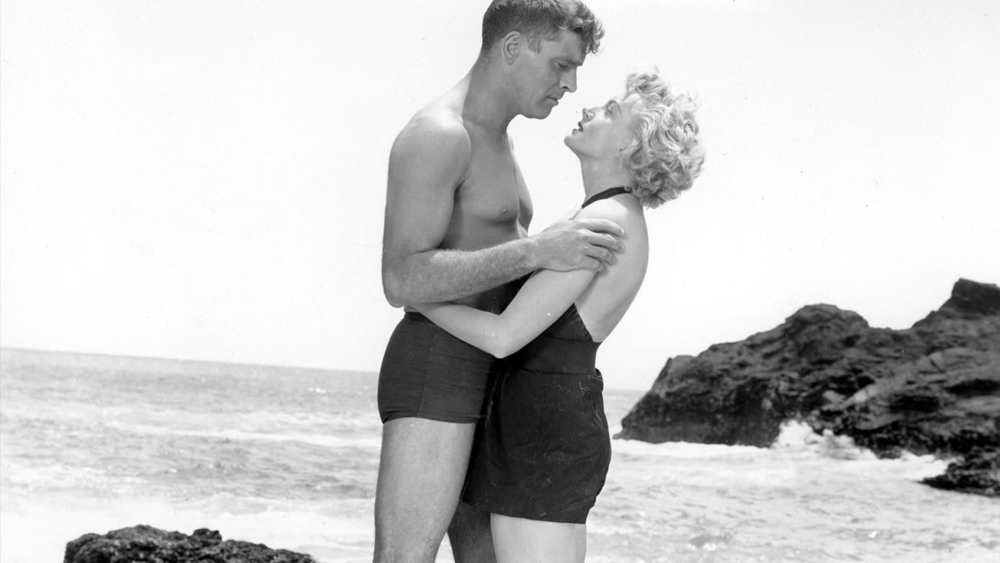
Fortunately, for Deborah Kerr, and for audiences everywhere, all that changed with 1953’s blush-worthy, beach-steamy role in From Here to Eternity. The actress once said about her career-pivoting moment in Hollywood, “I don’t think anyone knew I could act until I put on a bathing suit.” She was off and running. No more lackluster parts.
Deborah was proving that for as demure, refined, and classy, as she was described as being “off-screen,” this didn’t have to translate to the parts she could play “on-screen.” This revelation might seem like “old hat” here in modern 2025, but for the Old Hollywood studio system, it was quite progressive.
After 1953, Deborah “turned up the volume” on her characters and her career. She forged a new glittery, golden path that showcased her genre and character versatility – from Hollywood musical, drama, and romance, to comedy, thriller, and even horror. Additionally, though still beloved for continuing to play some of the best nannies, nuns, and lovely ladies ever captured on film, she still brought a much-appreciated depth to each of these characters.
Her characters often had sensitivity mixed with strength, and deep virtue mixed with flaws. Both traits could co-exist. They weren’t mutually exclusive. In short, Deborah was masterfully conveying “nuance.” As a result, audiences fell in love, and knew that they were watching a subtle, beautiful, highly-talented thespian.
Following up on her big blockbuster success in From Here to Eternity (1953), Deborah starred in one of the most popular, spectacular movie-musicals of all time, 1956’s The King and I. She plays a nineteenth-century widow schoolteacher who moves to Siam (present-day Thailand) to tutor King Mongkut’s megalithic brood of children.
Starring alongside famously bald Yul Brynner, Deborah is luminous in her colorful, big hoop skirts, and long red hair. However, striking appearance aside, her multi-faceted portrayal of Anna Leonowens is pitch-perfect. A lavish Technicolor masterpiece, The King and I was Deborah’s second big hit.
An Affair to Remember

Around this time, Deborah also starred in the provocative LGBTQ+ drama Tea and Sympathy (1956) and the World War II drama Heaven Knows, Mr. Allison (1957). Then, drumroll, she starred in the legendary tearjerker romance An Affair to Remember (1957). Cue Terry McKay’s famous finale-scene line – “If you can paint, I can walk!”
Yes, lovelorn Terry McKay is perhaps Deborah’s most well-known and treasured character by audiences, so much so that it even played a significant plot-point in the 1993 film Sleepless in Seattle, starring New Hollywood faves Tom Hanks and Meg Ryan. An Affair to Remember is Deborah Kerr’s “big hit #3.”
Deborah deftly portrays Terry McKay. Her protagonist is witty, sweet, lovable, and heart-breaking. Now one could argue that what actress wouldn’t be at their best with Old Hollywood’s “ultimate leading man,” Cary Grant, as their co-star. A big emphatic, “of course,” right? Still, one could also argue that Deborah brought out the best of Cary Grant in An Affair to Remember. His portrayal of sophisticated playboy Nickie Ferrante is iconic and career-defining. Theirs was a red-hot pairing, chock full of adorable banter, subtle soft-glances, and good old-fashioned passion. And who can forget that pink champagne?
Ranked a super-impressive #5 by the AFI (American Film Institute) in its list of 100 best romance movies compiled in 2002, An Affair to Remember is a romance that spans one glamorous ocean-liner in the Atlantic Ocean, one New York City skyscraper that is shrouded in confusion (and a thunderstorm!), and one Christmas-decorated apartment where neither character seems as if they’re going to break through their barriers to reconcile. No spoilers, but bring the tissues!
Deborah Kerr’s Groovy 1960s
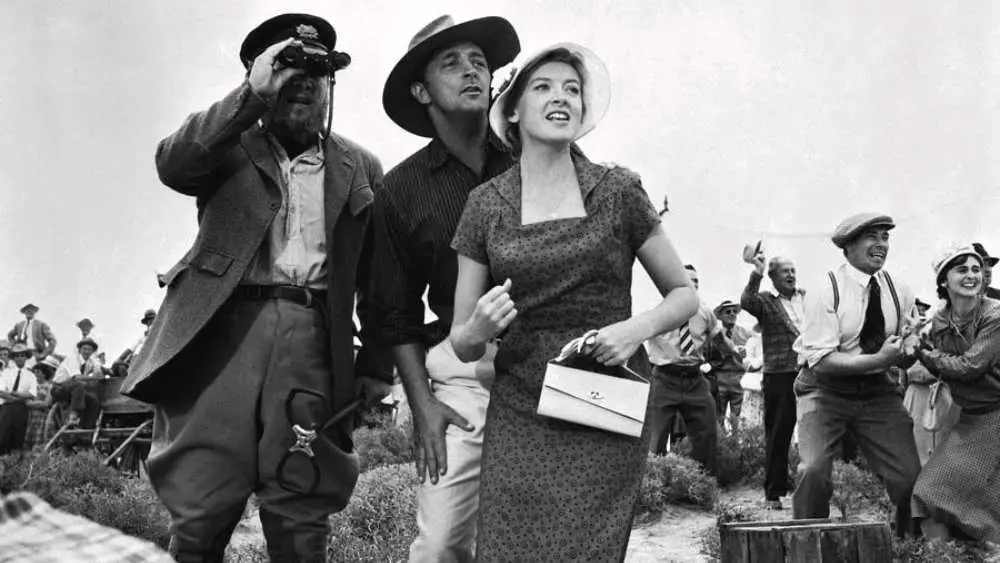
The 1960s saw Deborah continuing her reign as one of the most sought-after actresses, and she notably starred in the Australia-set film The Sundowners (1960), the bone-chilling horror masterpiece The Innocents (1961), and the ensemble-powered drama The Night of the Iguana (1964). She also took a progressive, groovy, flower-powered comedic turn with Marriage on the Rocks (1965), Casino Royale (1967), and Prudence and the Pill (1968).
Her final two 1960s flicks before retiring from the film industry (minus 1985’s The Assam Garden) were The Gypsy Moths (1969) and The Arrangement (1969). Both involved brief nudity for Deborah’s characters, and both were films that reflected the changing social and cinematic landscape. New Hollywood was here. The Hays Production Code (aka Hollywood’s morality code) dating back to the 1930s was now over. For better or worse, film was unflinchingly starting to explore nudity, violence, and the sometimes not-so-pretty parts of reality.
Kerr would likely have still shone brilliantly, like the solid, beautiful movie star that she was, but she decided to turn her attention to stage instead, and even a bit of fun TV movies in the 1980s. Further, as a woman who was nearing 50 years old, Hollywood in the 1960s would likely not have supplied her with those meaty parts that she had always so deserved. For instance, would she have been quickly ushered into proper British “grandmother” parts? Cringe.
Winning her Honorary Oscar for life achievement back in 1994, Deborah Kerr was a true “beauty in blue” as she walked center-stage to accept her highest accolade. At 72 years old, and away from Hollywood for decades, she endearingly said, “I’ve never been so frightened in all my life!” Her pastel blue dress and acceptance speech were positively sparkling.
Wrapping Up
Passing away in her native British Isles in 2007, at age 86, perhaps surrounded in cool, comforting lavender and rain, Deborah Kerr was a rare cinematic gift who was easily loved by all. Thank you, Deborah Kerr, for showing the world what it means to be a “lovely lady,” and incidentally, so much more. Cheers to that infamous, iconic bathing suit. A big Hawaiian “Aloha!”
[This piece was originally published on Aug 4, 2021]
Catch all the features from The Toast series here.

